


The NEOWISE Single-exposure Source Database contains multiple, independent detections of solar system, galactic and extragalactic sources made on all Single-exposure images taken during the first ten years of survey operations. All detections are included from all images, regardless of the quality of the image and the quality of the detections.
The NEOWISE Single-exposure Source Database contains all detections made on all of the Single-exposure images, regardless of the quality of those images. Some of the individual Single-exposure framesets are degraded by image smearing due to spacecraft motion, electronic noise, scattered light from the moon or other very bright objects near the field of view (e.g. III.2.c). The most reliable detections, and those with the least likelihood of contamination, can be identified using scores assigned during the Quality Assurance process in the Scan/frame Pipeline processing, or other metadata that is provided with each Database record.
The NEOWISE Single-exposure Source Database contains all source extractions from all Single-exposure images produced during Scan/frame processing regardless of their reliability. In addition to detections of real solar system, galactic and extragalactic sources, the Database contains spurious detections of noise excursions, transient events such as hot pixels, charged particle strikes, and satellite streaks, and image artifacts caused by bright sources such as latent images, diffraction spikes, and optical ghosts. In this section, we present suggestions on how to use the flags and metadata available with the Single-exposure Source Database entries to select extractions that are preferentially reliable source detections.
Most but not all of these tips pertain to both stationary background sources and moving solar system sources. Suggestions specific to identifying reliable solar system object detections are given in II.3.c.
One of the best ways to verify the reliability of a Single-exposure Source Database detection is to examine it on the NEOWISE Single-exposure Images. For stationary sources, it is also valuable to examine the position on the AllWISE Atlas Images that are both deeper than the Single-exposure images and benefit from pixel outlier rejection that suppresses transient pixel events.
In addition to visually examining their images, reliable detections in the Single-exposure Source Database can be selected preferentially using some or all of the following criteria:
Select W1 detections that have:
to minimize spurious transient detections. This filtering may also eliminate some real detections, as discussed in II.1.e.ii. The latter constraints (w?frtr like '0000') are more aggressive, and will produce more reliable, but less complete selections.
Elevated reduced chi-squared values do not always indicate source unreliability, though. Measurements of real sources that are significantly broader than the NEOWISE PSF, such as comets, compact nebulae, galaxies, or groups of sources that are not accurately deblended can also have large reduced-chi-squares. Similarly, measurements of isolated point sources can have large reduced chi-square values if the source image is contaminated by a cosmic ray strike, or if the centroid of the source falls close to a bad pixel on the detectors.
In general, cases for which the reduced chi-squared values are large (>2) indicate a violation of the statistical assumptions of the profile-fit measurement model. Moreover, there is no direct correlation between the reduced chi-squared values and quoted profile-fit photometric uncertainties because the latter are determined from an a priori error model (albeit with some data-dependent parameters) that does not incorporate the a posteriori information regarding the quality of the fit. Consequently, elevated chi-squared values for a detection can be a useful way to filter out poor-quality photometry of real sources independent of the photometric uncertainties.
Pixels in the NEOWISE W1 and W2 detectors that exhibit high noise levels or transient response behavior are identified in the bit-mask images, and are replaced with IEEE NaN (Not A Number) values in the intensity and uncertainty images (see IV.2.a.ii and IV.2.a.iii). The WSDS source detection and profile-fit photometry measurements are generally robust to the presence of a small number of NaN pixels within the measurement region for a source.
The great majority of masked pixels are isolated and distributed broadly over the detectors. However, as can be seen in the bit-mask images in IV.2.a.ii, there are a few collections of masked pixels on each detector that are large with respect to the size of fainter source images. Photometry and astrometry of sources that are coincident with the largest of these features in a Single-exposure may be corrupted, or in the worst cases, the source may not be detected at all.
A list of the central pixel coordinates and approximate sizes of the largest "clump-like" and "arc-like" or linear masked pixel features found on the W1 and W2 detectors are given in Tables 1 and 2, respectively. Thumbnail images of each of the masked pixel features are shown in Figures 3 and 4, where their sizes can be seen relative to the size of representative sources.
| Clump-like Features | x (pix) | y (pix) | radius (pix) |
|---|---|---|---|
| Feature W1-1 | 609.8 | 377.1 | 7 |
| Feature W1-2 | 302.7 | 611.7 | 6 |
| Feature W1-3 | 233.3 | 928.4 | 3 |
| Linear or Arc-like Features | x (pix) | y (pix) | length (pix) |
| Feature W1-4 | 212.3 | 166.0 | 66 |
| Feature W1-5 | 519.4 | 337.8 | 23 |
| Feature W1-6 | 69.1 | 735.6 | 15 |
| Feature W1-7 | 307.6 | 861.4 | 18 |
| Clump-like Features | x (pix) | y (pix) | radius (pix) |
|---|---|---|---|
| Feature W2-1 | 541.7 | 980.6 | 3 |
| Feature W2-2 | 637.4 | 701.8 | 2 |
| Feature W2-3 | 911.8 | 567.3 | 2 |
| Feature W2-4 | 955.5 | 457.3 | 3 |
| Linear or Arc-like Features | x (pix) | y (pix) | length (pix) |
| Feature W2-5 | 56.0 | 852.8 | 10 |
| Feature W2-6 | 560.3 | 133.0 | 10 |
| Feature W2-7 | 562.5 | 7.8 | 12 |
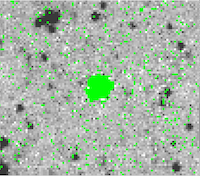 |
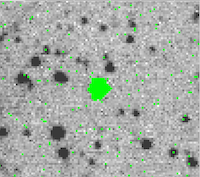 |
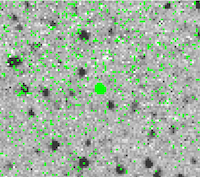 |
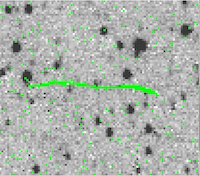 |
| Feature W1-1 | Feature W1-2 | Feature W1-3 | Feature W1-4 |
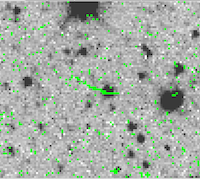 |
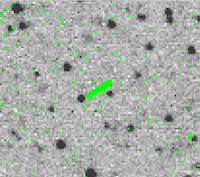 |
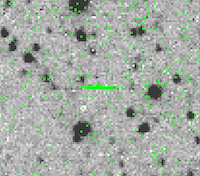 |
|
| Feature W1-5 | Feature W1-6 | Feature W1-7 | |
| Figure 3 - 100x100 pixel thumbnail images from single-exposure 94683a001 showing the clump-like and linear/arc-like masked pixel features in the NEOWISE W1 detector. Masked pixels are shown in green and have a value of NaN in the intensity and uncertainty images. The pixel location and approximate sizes of each of the features are given in Table 1. | |||
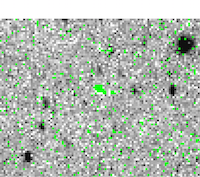 |
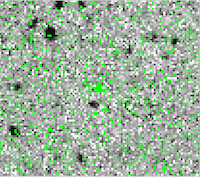 |
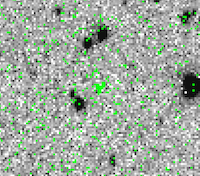 |
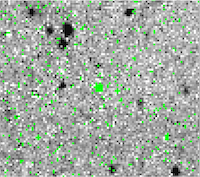 |
| Feature W2-1 | Feature W2-2 | Feature W2-3 | Feature W2-4 |
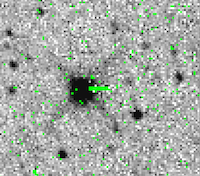 |
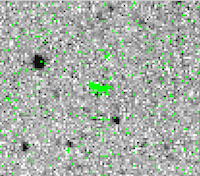 |
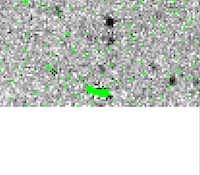 |
|
| Feature W2-5 | Feature W2-6 | Feature W2-7 | |
| Figure 4 - 100x100 pixel thumbnail images from single-exposure 94683a001 showing the clump-like and linear/arc-like masked pixel features in the NEOWISE W2 detector. Masked pixels are shown in green and have a value of NaN in the intensity and uncertainty images. The pixel location and approximate sizes of each of the features are given in Table 2. | |||
First, read sections II.3.a and II.3.b above to familiarize yourself with identifying reliable source detections in general.
The best way to identify Single-exposure Source Database entries that are reliable detections of solar system objects is to select entries that are part of a Moving Object Tracklet that was vetted by the IAU Minor Planet Center (MPC). The procedure for retrieving confirmed NEOWISE small body detections from the MPC Observations Database and then searching for them in the NEOWISE Single-exposure Source Database is described in IV.3.c.iii.
NEOWISE Single-exposure Source Database entries that are in close proximity to the predicted position of a known solar system object at the time of the Single-exposure may be flagged as a solar system object association (sso_flg=1). These are not confirmed solar system object detections. The majority of such flagged Database entries are either a chance association with a background source or spurious detection of noise or other artifacts. There are 25,354,861 entries in the Source Database with sso_flg=1, but only ~1.63 million NEOWISE solar system object detections were confirmed by the MPC during the 10.6 years of survey operations.
The Single-exposure Source database contains a small number of real solar system object detections that either were not reported to the MPC as part of Moving Object Tracklets, or that are not flagged with sso_flg=1. The automated moving object detection system will not link detections of very fast-moving objects that were in the NEOWISE field of view fewer than five times, or objects whose apparent acceleration and change in direction exceed the rate parameters allowed by the system. Solar system objects that were discovered after the epoch of the orbital elements file used for the known object searching during NEOWISE data processing (IV.2.e.ii) will not be flagged as possible solar system object associations.
Recovery of solar system object detections not associated with Moving Object Tracklets and/or not flagged as known objects can be done using the Solar System Object search facilities of the IRSA WISE/NEOWISE image and database search interfaces. Searches may be executed using object names or orbital elements.
Care must still be taken when interpreting Single-exposure Source Database entries that are returned by queries using the Solar System Object search capabilities. Reliable solar system object detections should satisfy most of the following criteria:
Masiero et al. 2020 (PSJ 1, 9) illustrate how detections of NEOs manually recovered from NEOWISE Single-exposures should be vetted.
Last update: 4 October 2024


